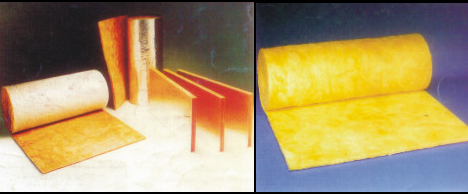|
GLASSWOOL IS USED AS A VERY EFFECTIVE INSULATION
Description :
One of the best thermal insulating materials is air, but motionless air. In order to immobilize the air, it is necessary to confine it in a network of the finest possible fibres. This is obtained from glasswool, which is made of 1% glass and 99% air.
Glasswool is produced from fine strand, long fibres of glass. Due to the manufacturing process used, the inclusion of non fiberized material (slugs or shot) is eliminated, resulting in only pure, thermally efficient fiberized glass. The fibres of Glasswool are inorganic manufactured from a natural raw material like sand, limestone, dolomite, rasorite and chemical products like sodium carbonate and sodium sulphate. The glass fibres are bonded with a Thermosetting phenolic resin. Glasswool contains no nutritional matter and hence provides no basis for growth of microorganisms nor will it sustain or attract insects.
Glasswool is light in weight, easy to cut, fit and handle. It can be applied with adhesives or mechanical fasteners. They also do not cause or accelerate corrosion of steel, copper or aluminium.
Glasswool is available in mainly two types viz. Aluminium Faced (ALF) & without aluminium facing i.e. Unfaced (UNF). As a protection against heat, Glasswool working in collaboration with good air conditioning is very efficient. In Industrial premises with internal insulation, alu-foil faced glasswool (ALF) is an excellent protection against heat radiation to building interiors from roofs and walls.
In buildings with external insulation of walls and flat roofs, glass wool regulates the thermal inertia of the building. It delays the rise in temperature of the masonry during the day and during cold nights it helps the radiation of heat gathered during the day, towards the inside of the building. In air-conditioned buildings, glasswool is a protection against the expensive negative thermic calories escaping through walls and roofing.
Glasswool conductivity like that of all insulating materials increases as the working temperature of its environment increases. It can withstand high temperatures upto 500 deg. C. Above 230 deg. C the binder may disappear without the thermal or mechanical qualities of either the pipe section or the board being affected. Glasswool conductivity is very low & is a function of product density. It has a high R value & hence better insulating properties.
Due to its tiny network of tightly intermingled elastic fibres, the glasswool is both the best absorbent of noise inside a room and the best insulation material against the propagation of noise from one room into another. Owing to its open structure, the glasswool offers the best sound absorption known to date. It is used either unfaced or faced as an element of suspended ceilings or acoustic baffles inside highly resonant premises that can present sound problems. It is also possible to adjust the sound absorption by modifying the product density, its thickness, its facing and its installation in accordance with various requirements. The elastic structure of the glasswool permits the separation of two elements of a double wall, preventing them from vibrating in unison, thus assuring the acoustic insulation between two rooms.
|
